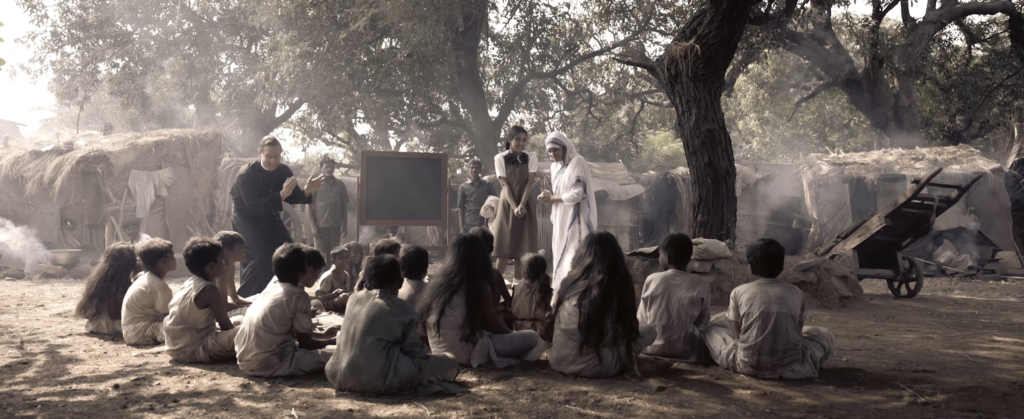One of the hallmarks of modern entertainment is the lionization of ambiguity. That can be a blessing or a curse. The days of heroes on horseback riding over the hill to save the day are relics of the past. The anti-hero and complicated protagonists are the new normal.
The ambiguity phenomenon rears its literary head in the new film “Mother Teresa and Me.” The title sounds like a feel-good film. Instead, what viewers get is a “think good” movie about two vastly different women. One is fictional, the other a real flesh-and-blood saint; both are complicated. Though separated by time and space, their shared emotional distress drives the plot and makes for a thought-provoking film.
It begins by telling Mother Teresa’s origin story, starting from her petitioning to be released from her position at a private girl’s school in Calcutta. She felt called by Jesus to care for the poor and the dying abandoned by their families to perish alone in the streets. Abandonment is the central theme of this film, as we find out when the film gets to Mother Teresa’s documented struggle with devastating feelings of being abandoned by Jesus.
The film’s characterization of Mother Teresa’s public and private life is one of holiness. While watching Mother Teresa in the throes of doubt, we meet her fictional counterpoint, Kavita (played by Banita Sandhu). Born in India and raised in early 21st-century London, she is in every sense the modern woman. She is fiercely independent, pursues a career in music, and rejects the wishes of her traditional parents — arranged marriage included.
She has two reasons to reject her parents’ matrimonial plan. She is absolute in her claim of personal autonomy, and she has just found out she is pregnant. Despite her proclamations of “pro-choice” feminist independence, something deep inside Kavita makes her run from the clinic where abortion is suggested as the remedy to her problem. When her boyfriend disappears like a puff of smoke on a windy day, Kativa’s own sense of abandonment spurs her to return to her birthplace of Calcutta and to the emotional support of a family friend.

This friend, it turns out, knows Mother Teresa through volunteer work with the Missionaries of Charity. When she brings the broken Kavita along with her to work, she is at first repulsed by what she sees. But her demeanor begins to change, especially when she is shown a Missionaries-run nursery that serves both as a House of the Dying and a Home for Life. The twin story arcs now begin to intertwine.
Most people who would struggle with doubt the way Mother Teresa did would have given up. She never did. The filmmakers do not have an answer to that — and why should they? That is God’s domain, and we are not privy to how Mother Teresa regained her spiritual equilibrium. The film chooses ambiguity as its answer, both in Mother Teresa’s dark night of the soul and with what Kavita will do when it comes to the child growing in her womb.
This is a film that was never going to end with an angelic choir singing in celestial harmony with the protagonists walking toward a pulsating white light. Either intentional or unintentional, the film still provides plenty of positive contemplation on the mystery of faith.
For the ordinary viewer, the topic of Mother Teresa’s prolonged, interior dark night of the soul may be the hardest to fathom. This experience of abandonment — revealed to the world when her personal letters were made public to the world a few years after her death — becomes the central point of the narrative of “Mother Teresa and Me.”
Last month, it generated some pushback from an important figure: the postulator of the nun’s sainthood cause. In a statement sent to media, Father Brian Kolodiecjchuk took issue with the film’s characterization of the saint in full, including the choice of actress Jacqueline Fritschi-Cornaz to play her. The priest believes and has centuries of Catholic mysticism to support the claim that Mother Teresa’s doubt was really a process of sainthood.
If the human nature of Jesus can cry out “My God, my God why have You abandoned me…” then who are we to suggest St. Teresa of Calcutta’s anguish was not part of her journey toward sanctity?
For the faithful, especially those of us who grew up with Mother Teresa, reopening the wound of Mother Teresa’s doubt hurts. “Mother Teresa and Me” will not erase that pain. But its honest portrayal of how selflessly she served the poor her entire life and how her saintly example can continue to impact the lives of 21st-century men and women makes this a film worth watching.

